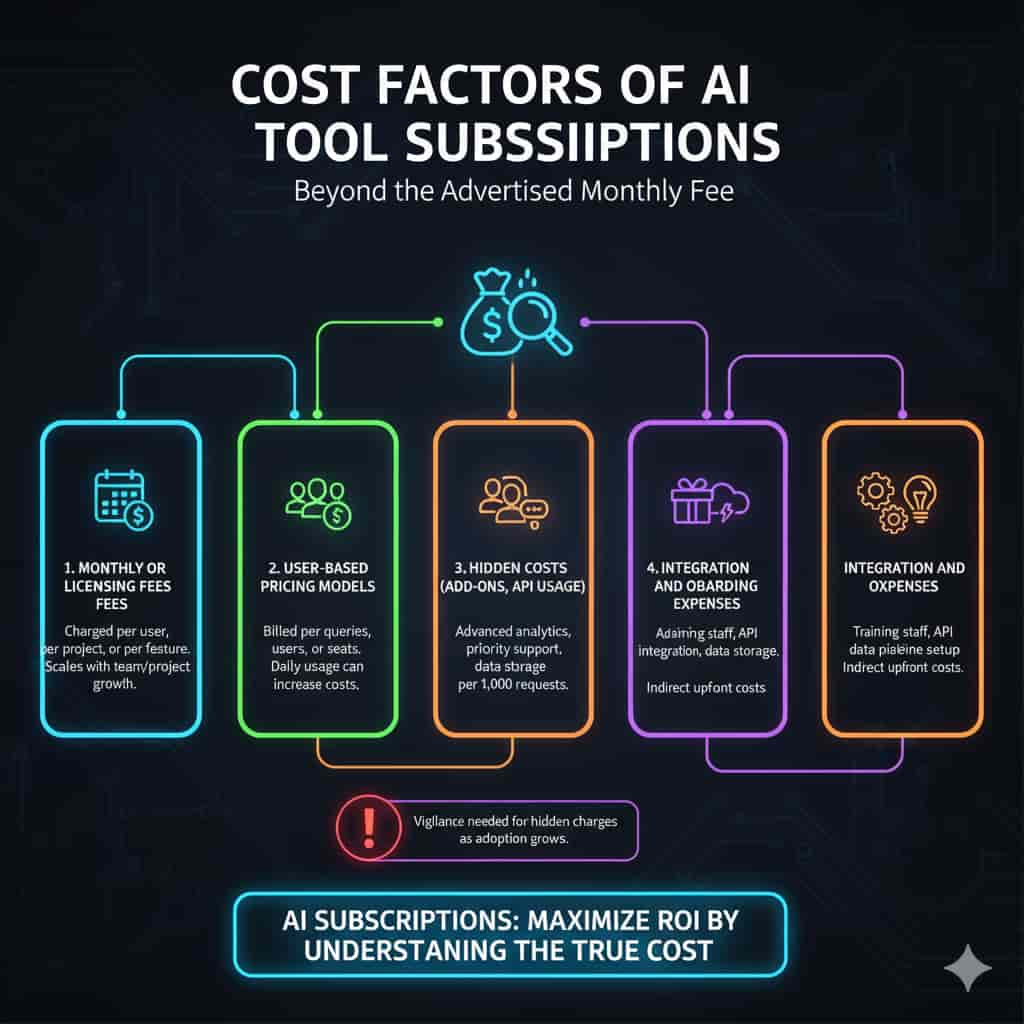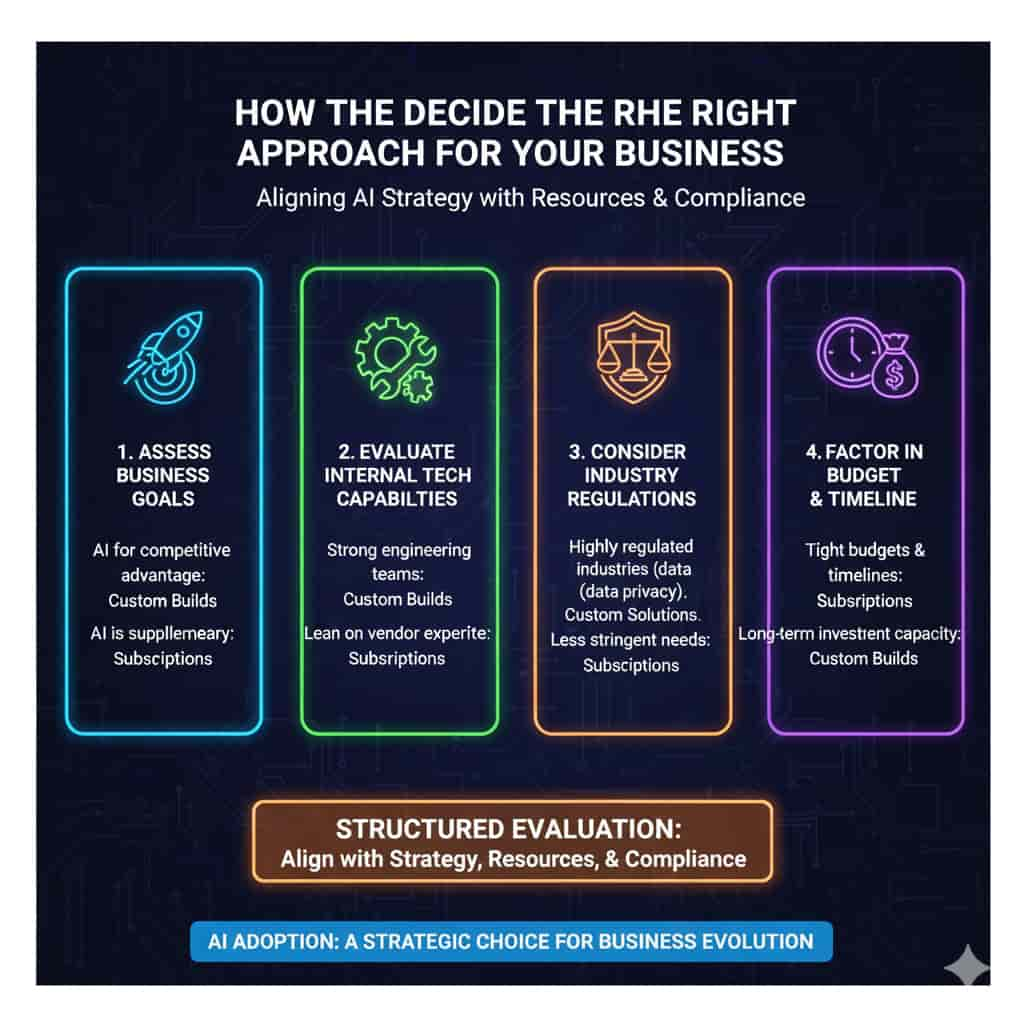1. Introduction
Artificial intelligence is no longer a futuristic concept; it’s now a strategic business decision. Organizations face a critical choice: invest in ready-made AI subscriptions or build custom solutions in-house. This decision impacts not just costs but also scalability, innovation, and long-term value. Let’s explore the trade-offs in detail.
2. What Are AI Tool Subscriptions and Custom Builds?
AI tool subscriptions are pre-packaged solutions offered by vendors on a monthly or annual basis. Think of them like renting software: you gain instant access to machine learning models, natural language processing, or computer vision tools without worrying about building from scratch.
These services often include cloud hosting, regular updates, and customer support. Examples include OpenAI’s API, Google Vertex AI, or DataRobot.
On the other hand, custom AI builds are like designing a house instead of renting an apartment. Businesses invest in developing AI solutions tailored to their unique needs. This approach requires assembling data science teams, investing in infrastructure, and managing long-term development.
A custom solution could involve building proprietary recommendation engines, fraud detection systems, or predictive analytics platforms.
Both approaches serve the same purpose, leveraging AI to enhance decision-making, efficiency, and competitiveness, but they differ in flexibility, cost structure, and control. Subscriptions prioritize speed and affordability, while custom builds emphasize personalization and ownership.
The challenge lies in deciding which model aligns better with a company’s goals. For instance, a startup may value speed and low entry costs, making subscriptions attractive. Meanwhile, a large enterprise with strict compliance needs may opt for custom builds.
In short, the choice is not just about software, it’s about strategy. Businesses must weigh upfront expenses against long-term value, balancing convenience with control.
3. Why Businesses Need to Compare Cost vs Value
Every business leader knows that cost and value aren’t the same. A solution that’s cheaper today may prove more expensive tomorrow if it doesn’t scale or align with strategy. Comparing subscription and custom AI builds ensures that organizations avoid short-sighted decisions.
Balancing short-term budgets with long-term ROI
Subscriptions usually offer lower upfront costs, which helps cash flow. However, if usage scales rapidly, recurring fees can accumulate. Custom builds require significant upfront spending but may pay off through ownership and reduced vendor dependency over time.
Aligning AI adoption with business strategy
Not every company needs a fully custom AI solution. If the strategic goal is rapid experimentation, subscriptions make sense. But if AI is central to competitive differentiation, say in healthcare diagnostics or financial risk modeling, then custom builds align better with long-term goals.
Managing risks of under- or over-investment
Jumping into subscriptions without understanding usage patterns may lead to spiraling costs. Similarly, over-investing in a custom build without sufficient in-house expertise risks failure. Businesses need to map risks against both cost and value, ensuring that investments bring measurable returns.
Ultimately, the decision isn’t about choosing the “cheapest” option; it’s about choosing the option that maximizes ROI while minimizing strategic risk.
4. Cost Factors of AI Tool Subscriptions
AI subscriptions may appear straightforward, but costs extend beyond the advertised monthly fee.
Monthly or annual licensing fees
Vendors typically charge per user, per project, or per feature. For small teams, costs are manageable, but at scale, licensing fees multiply.
User-based pricing models
Many AI platforms charge based on the number of queries, users, or seats. A marketing team using a language model daily could incur far higher costs than anticipated.
Hidden costs (add-ons, storage, API usage)
Subscriptions often include add-ons like advanced analytics, priority support, or data storage. API usage charges, often billed per 1,000 requests, can balloon unexpectedly as workloads increase.
Integration and onboarding expenses
Even subscription tools require setup. Training staff, integrating APIs into existing systems, and ensuring data pipelines function properly all add indirect costs.
While subscriptions reduce capital expenditure, businesses must remain vigilant about hidden charges that creep up as adoption grows.

5. Cost Factors of Custom AI Builds
Custom AI solutions come with a very different financial profile.
Initial development costs
Building from scratch requires hiring data scientists, engineers, and domain experts. Depending on complexity, development can cost anywhere from hundreds of thousands to millions of dollars.
Infrastructure and hardware requirements
Custom builds often require high-performance servers, GPUs, and cloud infrastructure. These costs add up, especially for compute-heavy applications like image recognition.
Ongoing maintenance and support
AI isn’t “set it and forget it.” Models degrade over time and require retraining, debugging, and optimization. Maintenance costs can rival initial development expenses.
Talent acquisition and training
Finding skilled AI professionals is difficult and expensive. Retaining them adds long-term salary obligations. Additionally, existing staff need training to effectively use and manage AI systems.
Opportunity costs of longer development timelines
Custom solutions take months, sometimes years, to deliver results. During this time, competitors using subscriptions may already capture market share.
Although expensive upfront, custom builds may reduce reliance on external vendors and generate significant long-term returns, provided the organization has the right resources and patience.
Read more: Secure Data Using Third Party AI APIs 2025
6. Value Drivers of AI Tool Subscriptions
Despite hidden costs, subscriptions deliver clear value.
Faster time-to-market
Subscriptions let businesses start immediately. A company can deploy an AI chatbot in weeks rather than months.
Vendor support and regular updates
Vendors handle bug fixes, model improvements, and compliance updates—saving internal teams from heavy lifting.
Scalable pricing for growth
Organizations can start small and increase usage as demand grows. This flexibility is attractive for startups and mid-sized businesses.
Lower upfront investment
Subscriptions eliminate the need for heavy capital investment, making AI accessible even to smaller organizations.
Subscriptions shine where speed, flexibility, and lower risk are priorities.
7. Value Drivers of Custom AI Builds
Custom builds provide value through deeper control and alignment with strategy.
Full control and customization
Organizations own the entire pipeline, from data preprocessing to deployment—allowing them to tailor systems exactly to their needs.
Competitive differentiation
When every competitor has access to the same subscription tools, custom solutions become a source of unique advantage.
Stronger alignment with business processes
Custom AI integrates seamlessly into workflows, avoiding the inefficiencies of adapting processes to third-party tools.
Potential for long-term cost savings
While upfront investment is high, custom builds may reduce recurring subscription fees and prevent vendor lock-in, leading to long-term financial benefits.
For industries where precision, compliance, or unique processes matter most, custom builds create strategic value beyond what subscriptions can offer.
8. Direct Comparison: Subscription vs Custom Build
8.1 Short-term vs long-term ROI
Subscriptions win in the short term with quick results and lower initial costs. Custom builds, though expensive upfront, can outpace subscriptions in ROI once they mature.
8.2 Scalability and flexibility
Subscriptions offer flexible scaling but come at recurring costs. Custom builds can be scaled at marginal cost once infrastructure is in place.
8.3 Security and compliance considerations
Subscriptions depend on vendor security standards, which may not satisfy strict industries like healthcare or finance. Custom builds allow for compliance-driven design but require significant effort to maintain.
8.4 Innovation and competitive advantage
Subscriptions democratize access to AI but limit differentiation. Custom builds foster unique innovation, making them essential for companies competing on AI-driven capabilities.
In practice, many organizations combine both, using subscriptions for standard tasks and building custom solutions for strategic needs.
Read more: AI for Data Analytics: 7 Powerful Tools to Leverage AI
9. How to Decide the Right Approach for Your Business
9.1 Assessing business goals and priorities
If AI is core to competitive advantage, custom builds may be worth the investment. If it’s supplementary, subscriptions suffice.
9.2 Evaluating internal technical capabilities
Organizations with strong engineering teams are better positioned for custom builds. Others may lean on vendor expertise.
9.3 Considering industry regulations and compliance
Highly regulated industries often require custom solutions to meet data privacy and compliance standards.
9.4 Factoring in budget and timeline constraints
Tight budgets and timelines favor subscriptions, while long-term investment capacity supports custom builds.
A structured evaluation ensures the chosen approach aligns with strategy, resources, and compliance needs.

10. Case Studies: Subscription vs Custom Build in Action
SaaS startup: subscription-based tools for speed
A SaaS startup used AI subscriptions for chatbots and analytics, enabling a product launch in weeks. Low upfront costs allowed focus on customer acquisition.
Enterprise healthcare provider: custom AI for compliance and precision
A hospital network developed a custom AI diagnostic tool. The investment was high, but it ensured compliance with medical standards and delivered more accurate patient insights.
Financial services firm: hybrid approach
A bank combined subscription-based fraud detection with custom risk modeling. This hybrid approach balanced speed with strategic ownership.
11. Common Mistakes to Avoid
- Choosing based on cost alone – Cheaper today may be costlier tomorrow.
- Ignoring hidden costs of subscriptions – API overuse and add-ons can balloon expenses.
- Underestimating ongoing maintenance for custom builds – AI requires constant updates.
- Failing to plan for scalability – Both models need scalability considerations to avoid bottlenecks.
Avoiding these mistakes helps maximize value from either approach.
12. Future Trends in AI Adoption Models
- Rise of hybrid AI strategies – Companies will increasingly mix subscriptions with custom modules.
- Increasing focus on ethical and explainable AI – Transparency will drive adoption decisions.
- Subscription platforms offering deeper customization options – Vendors will blur the line between out-of-the-box and custom builds.
The future lies in flexible, hybrid models that adapt to business needs.
Read more: Custom AI vs Pre-built AI: Best Fit for Your App in 2025
13. Conclusion
Choosing between AI subscriptions and custom builds is less about cost and more about strategic alignment. Subscriptions deliver speed and flexibility, while custom builds provide control and differentiation.
The smartest businesses evaluate both options, considering goals, resources, and risks. In many cases, a hybrid approach offers the best balance, leveraging the speed of subscriptions alongside the long-term value of custom solutions.
14. Frequently Asked Questions
1. What is the biggest advantage of AI subscriptions over custom builds?
Speed and affordability allow businesses to deploy AI quickly without heavy investment.
2. How much does a custom AI build typically cost?
Depending on complexity, costs range from $250,000 to several million dollars.
3. Are subscriptions scalable enough for enterprise use?
Yes, but costs increase with usage. Enterprises must carefully monitor growth.
4. Can businesses combine subscriptions with custom builds?
Absolutely. Many organizations adopt hybrid approaches to balance speed and control.
5. Which industries benefit most from custom AI builds?
Highly regulated industries like healthcare, finance, and defense are where compliance and precision are critical.
6. How do you calculate ROI for AI investments?
Measure costs against productivity gains, revenue growth, and reduced inefficiencies.
7. What risks come with relying on subscription-based AI tools?
Vendor lock-in, hidden costs, and limited customization.
8. How long does it take to develop a custom AI solution?
Typically 6–18 months, depending on complexity.
9. Do subscription AI tools meet enterprise security standards?
Many do, but industries with strict compliance requirements may need custom solutions.
10. Will custom builds remain viable as AI evolves?
Yes. In fact, they’ll become even more important for businesses seeking differentiation.


1 thought on “Top 10 Powerful Insights: Subscriptions vs Custom build AI”